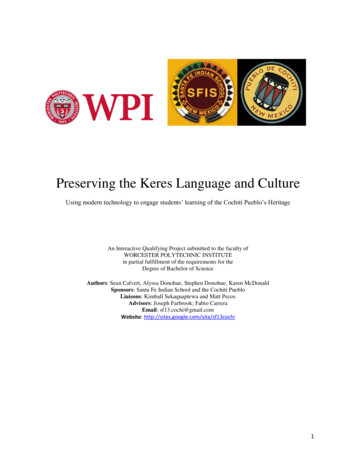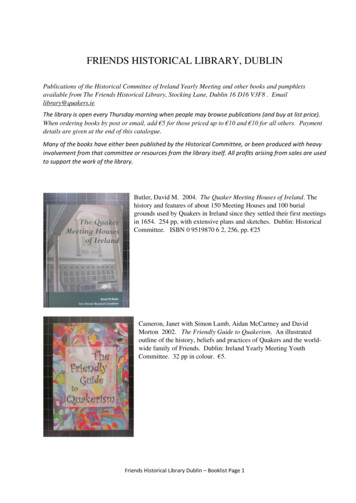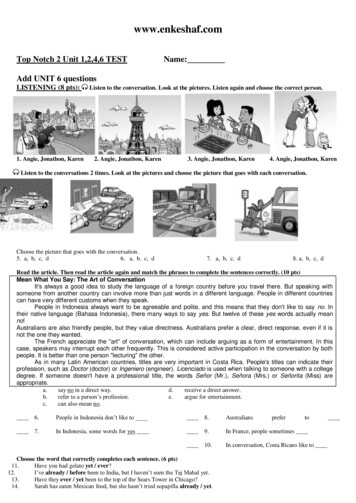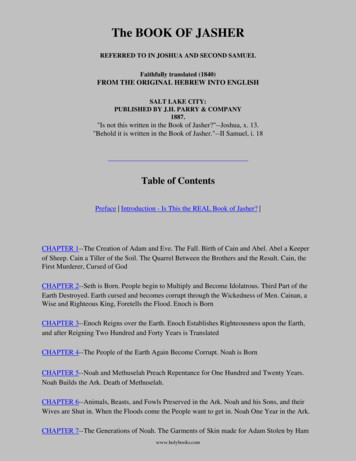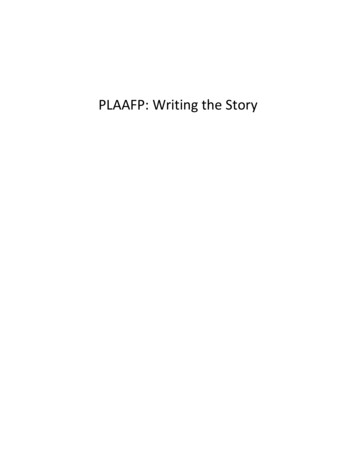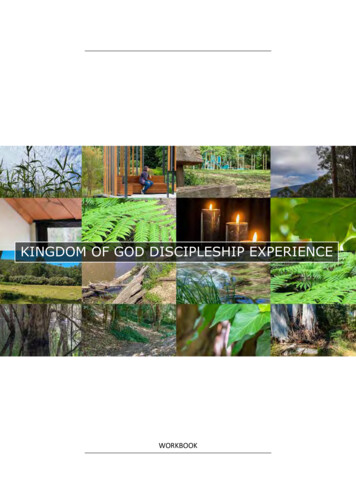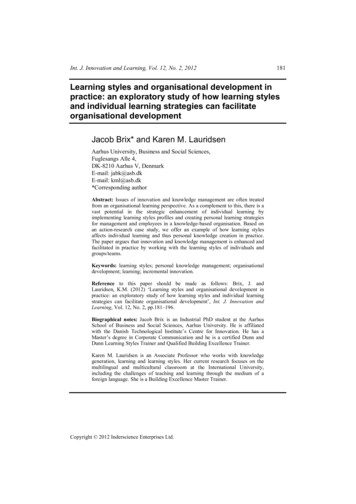
Transcription
Int. J. Innovation and Learning, Vol. 12, No. 2, 2012181Learning styles and organisational development inpractice: an exploratory study of how learning stylesand individual learning strategies can facilitateorganisational developmentJacob Brix* and Karen M. LauridsenAarhus University, Business and Social Sciences,Fuglesangs Alle 4,DK-8210 Aarhus V, DenmarkE-mail: jabk@asb.dkE-mail: kml@asb.dk*Corresponding authorAbstract: Issues of innovation and knowledge management are often treatedfrom an organisational learning perspective. As a complement to this, there is avast potential in the strategic enhancement of individual learning byimplementing learning styles profiles and creating personal learning strategiesfor management and employees in a knowledge-based organisation. Based onan action-research case study, we offer an example of how learning stylesaffects individual learning and thus personal knowledge creation in practice.The paper argues that innovation and knowledge management is enhanced andfacilitated in practice by working with the learning styles of individuals andgroups/teams.Keywords: learning styles; personal knowledge management; organisationaldevelopment; learning; incremental innovation.Reference to this paper should be made as follows: Brix, J. andLauridsen, K.M. (2012) ‘Learning styles and organisational development inpractice: an exploratory study of how learning styles and individual learningstrategies can facilitate organisational development’, Int. J. Innovation andLearning, Vol. 12, No. 2, pp.181–196.Biographical notes: Jacob Brix is an Industrial PhD student at the AarhusSchool of Business and Social Sciences, Aarhus University. He is affiliatedwith the Danish Technological Institute’s Centre for Innovation. He has aMaster’s degree in Corporate Communication and he is a certified Dunn andDunn Learning Styles Trainer and Qualified Building Excellence Trainer.Karen M. Lauridsen is an Associate Professor who works with knowledgegeneration, learning and learning styles. Her current research focuses on themultilingual and multicultural classroom at the International University,including the challenges of teaching and learning through the medium of aforeign language. She is a Building Excellence Master Trainer.Copyright 2012 Inderscience Enterprises Ltd.
1821J. Brix and K.M. LauridsenIntroductionKnowledge-based organisations (KBOs) wish to be innovative. A recent Scandinaviansurvey demonstrates this, because around 42% of the managers and employees askedstated that it is ‘very important’ to be innovative. However, only an average of 16% ofthem have formal procedures in place for working with innovation and hence knowledgemanagement in a strategic perspective (INNOVATIONinside, 2010; cf. also Drejer,2008). Until now, an individual learning perspective has typically not been addressed orarticulated in KBO-internal processes in practice (cf. Camuffo and Comacchio, 2004) butrather, when time is available, the locus of individual learning is supposed to be externalcourses (Belling et al., 2004; Cavaleri and Seivert, 2005). It is not to say that individuallearning is an unexplored theme (i.e., Lehesvirta, 2004; Stacey, 2003), but the interplaybetween individual learning and its effects on incremental innovation in internal workprocesses (Leonard, 1998), which we in our paper refer to as organisational development,is a key area of interest lacking empirical research evidence (Anderson et al., 2004;Crossan and Apaydin, 2010). In this context, a focus on the implementation of individuallearning strategies and the articulation of these strategies in a group/team context isneeded in order to assist managers and employees in creating organisational development(cf. Kjelgaard, 2009), and in a wider perspective to harness the potential for futureinnovation in general (Belling et al., 2004; Fagerberg, 2005; Lehesvirta, 2004).In this paper, we include the dimension of individual learning and its implications fororganisational development, namely individual learning strategies derived fromindividual learning styles profiles [for more details, see Section 5; Dunn and Griggs(2007) and Dunn and Rundle, (2007)]. The new dimension combined with ourfour-month clinical-inquiry action-research methodology (Bradbury and Rearson, 2008;Gnauer, 2010) has resulted in unique multidimensional data which through our analysisgives us new important perspectives for organisational development and allows us toavoid a one-dimensional perspective on innovation, as criticised by Anderson et al.(2004) and Fagerberg (2005). As a result, we set up as hypothesis that the application oflearning styles can positively affect individual learning, and thereby enhancecollaboration and communication in a group/team context, resulting in the incrementalprocess innovation we refer to as organisational development.2PremiseIn practice, employees and managers in KBOs often work under a constant time pressureand only little, if any, time is formally set aside for reflection or development of newideas (Argyris, 1991; Galavan et al., 2008; Sabri, 2005; Stadil and Waldstrøm, 2009).When time is not set aside for reflection, it is an unwise move on the part of the KBOsbecause the very key to learning and thus personal knowledge creation is by means ofreflection (Damasio, 2006; Davenport and Prusak, 1998; Restak, 2003). In addition, thecreation of intra- and interpersonal insights is often taken for granted in the strategic viewof knowledge management; top management does not emphasise the improvement ofcollaboration and teamwork and thereby the enhancement of social intelligence andinformation sharing capabilities (Argyris, 1990; Daghfous, 2004; Davenport and Prusak,1998; Kotter, 1999; Schultz, 2005). As a consequence of this, it is imperative to divertfocus to the aspect of individual learning in an organisational setting (Easterby-Smith and
Learning styles and organisational development in practice183Lyles, 2005) because individual learning and organisational development are intertwined(cf. Elkjaer, 2005; Goldman et al., 2009). Thus, when working strategically withknowledge management, the inclusion of an individual learning perspective creates thefoundation for successful initiatives in the organisational setting (Wiig, 1993). This viewis strengthened by Lauridsen (2010) who states that “learning does not only occur inclassrooms, but everywhere and whenever something new is to be learned or an oldroutine has to be changed and recreated” [Lauridsen (2010, p.10) authors’ translation].The arguments for focusing on individual learning and individual learning strategiesmentioned above are also addressed by multiple organisational psychologists, e.g., Hoggand Vaughan (2008), Kaufmann and Kaufmann (2008), and Schein (2004) whoemphasise that paying attention to the individual and how the individual person works ina group and how the group/team affects the individual when working, will enhancecollaboration, communication and thus the social working environment in organisations(Billett, 2002). Hence, the foundation of successful strategic knowledge managementinitiatives in organisations needs a strengthened understanding of the importance ofindividual learning strategies and the proactive use of these when working, especiallywith organisational development (also cf. Higgins and Mirza, 2010). With the insightsderived from the individual learning strategies, and by using the individual learningstrategies to create intra- and interpersonal insights in the KBOs, the gap between thedesired and the actual outcome of the knowledge management initiatives will close,leading towards a higher rate of success in the innovation processes due to enhancedcommunication and collaboration amongst co-workers (Argyris, 1991; Goleman et al.,2004; Kotter, 1999; Pegels, 1998).3MethodologyThe range of empirical studies regarding innovation processes in practice have explodedduring the last couple of decades (Crossan and Apaydin, 2010), and this tendency hasshown no sign of diminishing. However, the vast majority of existing research discussesand concludes on one-dimensional perspectives of the innovation process in practicewhich can result in the danger of ‘routinisation of the innovation research’ (Anderson etal., 2004) and thus keep the research in a myopically directed perspective. It goes withoutsaying that the one-dimensional research approaches have contributed immensely to theunderstanding of innovation in both research and in practice, but still the very creation ofinnovation remains an enigma (Fagerberg, 2005).In the light of this we chose to apply Schein’s clinical inquiry action research to ourstudy (Bradbury and Rearson, 2007; Schein, 2004). The clinical inquiry action research isa scientific orientation of inquiry where participation in and exploration of organisationalpractices and processes are understood at first hand by the researcher(s) (ibid.). Hence,full participation is required in all processes to collect valid data together with thepossibility of creating emancipatory interventions where current processes are rethoughtand changed by removing all basic assumptions and taken-for-granted perceptions in theorganisational culture and business processes (Eden and Huxham, 1996). In our study weparticipated on a daily basis in the work at the unit of analysis in a period of four months,gathering data both by observing, questioning and participating in the actual work at theunit of analysis, resulting in a first hand understanding of the full work processes and theculture in which the work was done (cf. also Gnauer, 2010). During the action research
184J. Brix and K.M. Lauridsenprocess we made several interventions with staff and management based on a learningdialogue, where the existing work processes were critically reflected upon (ibid.). Finally,staff and management validated the value of our interventions in order to createwell-founded conclusions of the action research (Workman, 2007). Two general normsfollow the action research orientation: First of all, research is effectuated as an ongoingiterative and progressive process where adaptation is required according to the concurrentfindings (cf. Bradbury and Rearson, 2007; Schein, 2004). In short, the authors could notset up parameters for research beforehand or know what would emerge during theparticipatory research method. For this reason, this paper describes and analyses only oneof the interventions made during our research period, and the paper is henceforthdelimited to analyse this intervention with the complete research data regarding theobservations we made during our study. Secondly, statistics is not required to validate theconclusions because the means of validation used in the natural sciences do not fitquestions about the development of human thinking and acting. Hence, the scientificorientation seeks to create functional solutions for organisational practice, and theverification process is completed in cooperation with the clinical inquirer and theorganisation being researched (Bradbury and Rearson, 2007; Eden and Huxham, 1996;Schein, 2004). Finally, the conclusions deriving from action research are bound in thehistorical and culturally specific context in which they have been constructed (Anderson,1995; Burr, 2001).4Ontological foundationThe study is founded in a social constructionist ontology since a critical emancipatorystance toward the concept of knowledge management is required. The socialconstructionist ontology suggests that taken-for-granted assumptions (Burr, 2001) aboutwhat is real should be removed and reconsidered in order to eliminate Einstellung(Eysenck and Keane, 2007) which is a state of mind where habituation of problemsolving and/or job performance lead to a blind attitude towards new ways of thinking andthus create a tunnel view for the employees that prevent them from creating incrementalinnovation in the business processes (Drucker, 1993). When critically questioning theexisting Einstellung in practice, the path for future innovative development and new waysof thinking is thus cleared (Blackman and Murray, 2006; Da Bono, 1970; Garrido, 2009;Tushman and Anderson, 1997). Although a social constructionist stand is taken, it is in itsless rigorous form of essentialism (Burr, 2001). The essentialist view argues that allindividuals have their own personality and that personal essence is present in all humanbeings. Knowledge and the truth(s) about knowledge are constructed socially, and it isthus possible to have multiple truths. Likewise, the juxtapositioning of opposite truths isbecoming generally accepted (cf. Firat and Venkatesh, 1995) which, e.g., is demonstratedin practice by the emergence of new and successful business models in saturated markets(Lee and Chang, 2007; Gottschalk, 2006). In sum, what is accepted as a right and usefulprocess for one KBO can be found impeding and henceforth false by another similarKBO (Davenport, 2005; Drejer, 2008).Because we argue that every truth is a subjective evaluation based on emotions aswell as reasoning, we stress that the Cartesian dualism (Damasio, 2006; Warburton,2006) should not be taken into consideration in a study taking its point of departure in theaction research orientation. Descartes stated that the creation of objectivity was possible
Learning styles and organisational development in practice185by leaving out emotions during an evaluation process (Damasio, 2006; Warburton, 2006).Contrary to Descartes, we argue that the accomplishment of objectivity is not possibleand that, instead, it is appropriate to evaluate and reflect upon the processes and methodsthat result in successful practices and to subsequently draw conclusions based on alearning dialogue with the members of the organisation being studied (Damasio, 2006;Elkjaer, 2005; Klingberg, 2009; Restak, 2003; Scharmer, 2009).5Data – information – personal knowledge managementWhen initiating a strategic perspective on knowledge and innovation management, it isnecessary to make a clear distinction between the concepts of data, information andknowledge (Davenport and Prusak, 1998). Many practitioners – and also academics – usethese concepts interchangeably without distinguishing between the data or informationcarriers on the one hand and knowledge as a result of individual learning processes on theother (cf. e.g., Kjelgaard, 2009; Lauridsen and Lauridsen, 2009). Hence, it is arguedthat the work of Kastberg et al. (2007) coining the concept of personal knowledgemanagement is utterly important because organisational development is inhibited unlesswe change perspective from the educational paradigm focusing on a sender and a receiverof objectified knowledge (Correa Da Silva and Agusti-Cullell, 2008) to a learningparadigm where emphasis is on learning as a result of individual cognitive processesconstructing personal knowledge (cf. also Damasio, 2000; Gardner, 2003; Newell, 2009;Prince, 2004; Zull, 2002).Based on this perspective, we support other scholars who state that the term‘organisational learning’ is misguiding (i.e., Bennett and Bennett, 2008; Goldman et al.,2009; Newell et al., 2009; Stacey, 2003) because it is based on an objectified view ofknowledge, stating that knowledge can be managed at an organisational level and thusstored on hard drives for future usage. This view thus devaluates the very concept oflearning, because it treats learning as a manageable process controlled by others than theindividuals themselves (Leonard, 1998). Instead, we claim that knowledge creation is theresult of an individual learning process. Only individuals can learn, not organisations assuch. Henceforth, the perspective on personal knowledge management is argued to be akey factor for successful learning in KBOs where it is stressed that only information canbe communicated through phone-calls, e-mails, reports, dialogue, etc. (cf. also Kastberget al., 2007). Then, if the employee/manager has worked actively with the informationand thus created new personal knowledge based upon it, the information sharing at theorganisational level is successful because new personal knowledge has been created bymeans of it (Davenport and Prusak, 1998; Kastberg et al., 2007; Kjelgaard, 2009;Lauridsen, 2010).6Learning styles and personal knowledge managementBecause we argue that individual learning is the key element of personal knowledgemanagement, we stress that the implementation of learning styles into organisationalpractice is vital. For example, Kjelgaard (2009) states that insights about individuallearning strategies will create enhanced personal learning capabilities for the individuals,and it will create a mutual understanding at the organisation of how the individuals can
186J. Brix and K.M. Lauridsenwork more strategically with their personal knowledge according to their individuallearning styles strategies (cf. also Lauridsen, 2010). In our study, we utilised Rundle andDunn’s Building Excellence (BE) model and survey (Dunn and Rundle, 2007) as a tool tounderstand central aspects of personal learning in the KBO we analysed (see Figure 1below).Figure 1The Building Excellence model (see online version for colours)The BE model and survey are based on Dunn and Dunn’s learning styles construct whichis one of the most evidence-based learning styles models to date (Dunn and Griggs, 2007;Lauridsen, 2010; Lauridsen and Lauridsen, 2009). The BE learning styles model operateswith six groups of elements: the perceptual, the psychological, the physiological, theenvironmental, the emotional and the social groups of elements. The six groups contain20 elements with altogether 28 variables that may influence individual adult learning.This may be a positive influence when an individual exploits his/her preferences, andnegative when that is not the case (Dunn and Rundle, 2007). Even though the BE modelhas been validated in research (Rundle, 2010), it may still be revised, e.g., as a result ofthe neuroscientific research conducted by Thies (2001, 2007). According to Thies (2001,2007), the BE model addresses factors that are key to the three important functions of thebrain in the individual learning process, that is, the arousal, the executive and theprocessing functions, thereby adding a further argument to why the BE model is anadequate tool in this context (cf. Bennett and Bennett, 2008; Kjelgaard, 2009). For moreinformation about the BE, see http://www.learningstyles.net.
Learning styles and organisational development in practice187In addition to the BE model, Martin Buber’s philosophy of intersubjectivity (Buber,1923) is applied in the inquiry as a tool needed to explain in greater detail how employeesinteract with one another. Buber’s philosophy of intersubjectivity is an interactiondualism, or dichotomy, containing I and It relationships, and I and Thou relationships(Buber, 1923; Goleman, 2006). An I and It relationship is engaged when person A usesperson B as an object and demonstrates no personal interest or feelings. Instead, the I andThou relationship is established where interest is demonstrated, and where persons A andB listen to one another and both feel communion, where they are being accepted asequally important to the social construction they are part of (Bakan, 1966; Buber, 1923;Goleman, 2006). Applying Buber’s dichotomy as a language tool has provided theemployees with at set of terms to use when they do not feel communion during peakworking periods.7Unit of analysis, the case of Strategy-LabStrategy-Lab was the unit of analysis in our research. It used to be a research centre runas a private professional consultancy at the Aarhus School of Business, AarhusUniversity (Denmark), working with the development of cutting edge business strategies,academic sparring and innovation management. The lab was supposed to generate itsown funding and while the organisational setting has since changed, Strategy-Lab stillspots trends and state-of-the-art practices in real life businesses, now being a fully-privateconsultancy which is the result if a university spin off (http://www.strategylab.dk).8Research design and data collectionThe study was designed as illustrated in Figure 2 below.Figure 2Operational method for the clinical inquiry action research (see online versionfor colours)
188J. Brix and K.M. LauridsenThe first step of the data collection in the clinical inquiry was to observe and investigatethe existing information work processes, the behaviours and the organisational culture atStrategy-Lab. In practice, we observed how the employees used the existing artefacts andhow they interacted with one another (Schein, 2004). We then described our observationsand took pictures (not included) to illustrate and document our findings. In the analysiswe evaluated if and how the usage of the artefacts in the communication and interactionprocesses could be improved. We wanted to investigate if/how individual learning stylesand strategies could influence the work processes at the unit of analysis, and as anintervention we asked the employees to fill out the online BE learning styles survey andread their final individual report resulting from it. The authors gained access to theindividual reports, compared and analysed the individual learning styles preferences andthe strategies presented in the reports of the individual team members. This analysiscreated valuable insights and we presented these to the employees and the managementas part of our intervention. This gave the employees and the management anunderstanding of how to enhance their personal learning in practice and of how to worktogether with one another in accordance with their individual learning style preferencesand strengths. To conclude our intervention we conducted emancipatory interviews andasked the individual employees about their personal opinions, attitudes and preferencesregarding the analysed results of the BE Survey and the documented observations in theaction research. After our analysis and intervention, some results were transferreddirectly to the conclusion, whereas the insights we had created that could not be validatedby the research data alone, were elaborated upon and presented to the team members andthe management at another critical intervention. During the second intervention, theemployees discussed and reflected upon which processes and new initiatives theybelieved could improve the future information sharing processes and thus develop asuccessful strategy for individual learning, cooperation in groups/teams and thus result inorganisational development. The new processes and socially created insights weretransferred into the final conclusion. Finally, the clinical inquiry action research wasverified by the director of the Strategy-Lab. The verification process was carried out inorder to ensure the quality of the research process, and by extension to verify if it hadbeen successfully concluded (Bradbury and Rearson, 2008; Schein, 2004).9AnalysisThe analysis is summed up in three individual sections, the description anddocumentation of our observations, the BE learning styles results, and the emancipatoryinterviews.9.1 The observationsOpenness and special interest in the action research project was demonstrated, and theteam members accepted the importance of our inquiry regarding enhancedcommunication and information skills. We observed that the interpersonal relationsamong team members were maintained by frequent face-to-face interactions. Moreover,there was an informal atmosphere where everyone was looked upon as equal, andemphasis was on informal contact when specific information was needed. Whenever theemployees did not meet face-to-face, we observed that various communication tools were
Learning styles and organisational development in practice189applied. The most commonly used communication channel was e-mailing. E-mailswere primarily used for personal notes, sharing of general information and for planningmeetings and events. Likewise, we observed that instant messaging was frequentlyused as a tool for conversation between two individuals when they needed to agreeupon certain elements without disturbing other colleagues in the open office spaces.The phones were seldom used internally because of the close proximity of employeesin the office landscapes. At meetings we noticed that there were clear differencesbetween the employees attending. Some of them did not talk much, and others kepton talking even though something was presented by others. A couple of them oftenseemed restless, and when they started to rock their chairs and play with their pens, cellphones or watches, we experienced firsthand that it created a destabilised meetingenvironment.9.2 The results from the BE surveyThe analysis of the individual learning styles reports was collected into a group profile, ateam mastery profile, which led to the following insights. The use of auditory informationsharing media alone can inhibit mutual understanding and information processing inStrategy-Lab. Only a couple of individuals in the group have a demonstrated auditorystrength. The analysis gives strong indications towards more multi-modal approaches forintra-group information sharing and personal knowledge creation, where the combinationof different modes such as pictures and texts as well as tactual and kinesthetic elementsare important to apply when striving for enhanced understanding and retention. Theauditory verbal aspect of learning is a common strength in the group; individual teammembers need to express themselves aloud in order to remember and enhance theirpersonal learning capabilities. The analysis moreover indicated that most of theemployees were very tactual and kinesthetic which could explain the restless behaviourobserved during meetings.As for environmental elements, silence was needed in order to improve theinformation processing of team members, a challenge in the open office landscapes withmuch sound and disturbance. Individual adjustable lights should be present at theworking stations in order to adjust the level of light to accommodate personalpreferences. Additionally, a diversity of preferences was demonstrated as regards thetemperature in the offices because some individuals preferred having a coolertemperature while others preferred a warmer temperature. Hence, compromises should bemade in order to create an acceptable temperature for everyone involved. The teammastery profile moreover demonstrated that the conservative office schemas (Hoggand Vaughan, 2008) should be broken down because only a few of the employeesare able to concentrate on complex work, when working in a chair and/or at a desk.Thus, the insights from the BE profiles demonstrated that the majority of the employeesshould place themselves as comfortably as possible during work. As a result, themanagement bought two couches and created a lounge area for reading and havingmeetings.As for time of day, meetings should be held in a time slot between 10:00 AM and3:00 PM in order to have the employees as focused as possible on their tasks, therebyallowing them to cognitively process complex information. At other times of day, itwould be wise to plan routine jobs and administrative work tasks. Additionally, theresults from the analysis of the team mastery profile made it clear that eating snacks
190J. Brix and K.M. Lauridsenduring meetings was vital to maintain the employees’ concentration; and the analysisfurther demonstrated that walking around while working and having meetings, therebyenhancing mobility, would also enhance the concentration among the majority of theemployees and assist them in taking advantage of their personal learning styles strengthsand personal knowledge management capabilities when creating new personalknowledge.Finally, the learning styles analysis demonstrated that the team members are nonconforming, and that they prefer to create their own personal structure in the work theyare doing. In addition to this, most of them have a demonstrated preference for workingin pairs or small groups instead of working alone.9.3 Emancipatory interviewsThe emancipatory interviews were based upon questions deriving from the authors’observations during the action research and the results from the individual learning stylesprofiles plus the team mastery profile. This section is therefore based on the authors’insights from the learning styles analysis and the observations at the research centre.1The learning styles analysisDuring the interviews and the analysis of the interview data, it was revealed that theemployees generally believed that dialogues were the best and most time efficientway of understanding one another and thus learning from one another. This attitudecould be explained by referring to the BE results which demonstrated that working inpairs was one of the great learning style preferences at the research centre, in whichit is possible to reach a common understanding and thus sum up what has to be done.Moreover, we argue that when the employees work in pairs, they articulate theinformation aloud, which supports the auditory-verbal aspects of the perceptualelements in the BE model. Thus, according to the employees, general informationsharing would be optimised if it was based on interaction and dialogue rather thanone-way written communication such as e-mails, etc. Furthermore, dialogues werefound to assist in creating clarity about social acceptance and validity becauseattention was directed at the importance of being on the right track when working onprojects. Hence, the BE results regarding motivation, that is, the need for feedback ornot, was demonstrated to have influenced the daily work processes. In addition tothis, it was emphasised that being face-to-face with other colleagues was a good wayto maintain personal relations, and it was the opt
Karen M. Lauridsen is an Associate Professor who works with knowledge generation, learning and learning styles. Her current research focuses on the multilingual and multicultural classroom at the International University, including the challenges of teaching and learning through the medium of a foreign language.

